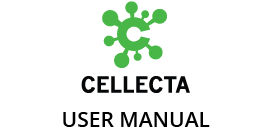This step enables specific amplification of barcodes from genomic DNA using two rounds of PCR with vector-specific primers flanking the barcode.
1. First Round PCR Step
Prepare the First PCR Master Mix according to the example below. Adjust the amount of Master Mix depending on number of samples, including enough to run the included Positive Control Template DNA (1 µg per test tube) and one negative control (1 µg of genomic DNA sample without barcoded insert).
| Volume | Component |
|---|---|
| 5 µl | 200 ng/µl Genomic DNA (1 µg) |
| 5 µl | First PCR Primer Mix * |
| 2 µl | 50X dNTP Mix (10 mM each) |
| 5 µl | 10X Taq Polymerase Buffer |
| 32 µl | PCR-Grade Water |
| 1 µl | 50X Taq Polymerase |
| 50 µl | Total volume |
* If using CloneTracker XP Barcode Panel constructs, use 2.5 µl of each of the Forward-XP and Reverse-XP primers.
Perform PCR under the following cycling conditions.
| 94°C, 1 minute | 1 cycle |
| 94°C, 15 seconds, 60°C, 15 seconds, 72°C, 30 seconds |
20 cycles |
| 72°C, 2 minutes | 1 cycle |
2. Second Round PCR Step
Use a 5 µl aliquot from First PCR Step above in the second round of PCR with nested primers:
| Volume | Component |
|---|---|
| 5 µl | First Round PCR Product |
| 5 µl | Second PCR Primer Mix ** |
| 2 µl | 50X dNTP Mix (10 mM each) |
| 5 µl | 10X Taq Polymerase Buffer |
| 35 µl | PCR-Grade Water |
| 1 µl | 50X Taq Polymerase |
| 50 µl | Total volume |
* If using CloneTracker XP Barcode Panel constructs, use 2.5 µl of each of the NFwd-XP and NRev-XP Index A primers.
Perform PCR under the following cycling conditions.
| 94°C, 1 minute | 1 cycle |
| 94°C, 15 seconds, 65°C, 15 seconds, 72°C, 30 seconds |
16 cycles |
| 72°C, 2 minutes | 1 cycle |
3. PCR Product Analysis
Analyze the PCR products by gel electrophoresis on a 3.5% agarose-1xTAE gel (load 5 µl/lane), an Agilent Bioanalyzer, or an AATI Fragment Analyzer. The gel electrophoresis analysis should reveal a bright band of amplified barcode products (251 bp product for BCRPP5/10-V kits or a set of up to four PCR products with sizes of 121, 141, 161, and 181 bp for the BC4P-V kit) (see Figure below for example results) with intensities similar to the Positive Control Template DNA sample. Run additional cycles if the experimental sample shows very weak (2-3 cycles) or no visible band (5 cycles). Repeat analysis of amplified products on a 3.5% agarose-1xTAE gel in order to ensure similar yields of amplified barcode products for all samples.
For cells barcoded with the Barcode-Plus constructs (Cat.# BC4P-V), the relative intensities of four differently-sized bands (each band specific for one of the unique barcodes) provide an estimate of the number of cells with each barcode in the population (see Figure below). The four PCR products present in the size range of 121-181 bp can be quantified by subtracting the background density of the negative control sample from the density of the bands on the gel using software available on most imaging stations, such as the Bioanalyzer or Fragment Analyzer. The Positive Control sample with a mix of four barcoded genomic DNA samples mixed in equal amounts can be used as a normalization control. If any barcodes exhibit too low an intensity to measure, place the samples back into the thermal cycler and perform an additional 2-4 cycles. However, avoid overcycling which can result in the generation of a longer fragment that corresponds to a fusion double barcode product.
Need more help with this?
Contact Us


